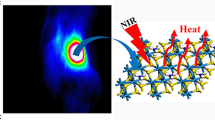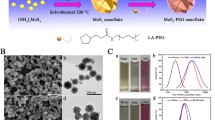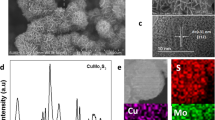Abstract
Nanomaterials with intense near-infrared (NIR) absorption exhibit effective photon-to-thermal energy transfer capabilities and can generate heat to ablate cancer cells, thus playing a pivotal role in photothermal cancer therapeutics. Herein, hydrophilic flower-like bismuth sulfur (Bi2S3) superstructures with uniform size and improved NIR absorption were controllably synthesized via a facile solvothermal procedure assisted by polyvinylpyrrolidone (PVP), which could adjust the product morphology. Induced by an 808-nm laser, the as-prepared Bi2S3 nanoflowers exhibited much higher photothermal conversion efficiency (64.3%) than that of Bi2S3 nanobelts (36.5%) prepared in the absence of PVP. This can be attributed not only to the Bi2S3 nanoflower superstructures assembled by 3-dimensional crumpled-paper-like nanosheets serving as many laser-cavity mirrors with improved reflectivity and absorption of NIR light but also to the amorphous structures with a lower band gap. Thus, to achieve the same temperature increase, the concentration or laser power density could be greatly reduced when using Bi2S3 nanoflowers compared to when using Bi2S3 nanobelts, which makes them more favorable for use in therapy due to decreased toxicity. Furthermore, these Bi2S3 nanoflowers effectively achieved photothermal ablation of cancer cells in vitro and in vivo. These results not only supported the Bi2S3 nanoflowers as a promising photothermal agent for cancer therapy but also paved an approach to exploit new agents with improved photothermal efficiency.

Similar content being viewed by others
References
Cheng, L.; Wang, C.; Feng, L. Z.; Yang, K.; Liu, Z. Functional nanomaterials for phototherapies of cancer. Chem. Rev. 2014, 114, 10869–10939.
Song, X. J.; Chen, Q.; Liu, Z. Recent advances in the development of organic photothermal nano-agents. Nano Res. 2015, 8, 340–354.
Kang, S.; Bhang, S. H.; Hwang, S.; Yoon, J.-K.; Song, J.; Jang, H.-K.; Kim, S.; Kim, B.-S. Mesenchymal stem cells aggregate and deliver gold nanoparticles to tumors for photothermal therapy. ACS Nano 2015, 9, 9678–9690.
Sugiura, T.; Matsuki, D.; Okajima, J.; Komiya, A.; Mori, S.; Maruyama, S.; Kodama, T. Photothermal therapy of tumors in lymph nodes using gold nanorods and near-infrared laser light with controlled surface cooling. Nano Res. 2015, 8, 3842–3852.
Xia, Y. N.; Li, W. Y.; Cobley, C. M.; Chen, J. Y.; Xia, X. H.; Zhang, Q.; Yang, M. X.; Cho, E. C.; Brown, P. K. Gold nanocages: From synthesis to theranostic applications. Acc. Chem. Res. 2011, 44, 914–924.
Huang, X. Q.; Tang, S. H.; Mu, X. L.; Dai, Y.; Chen, G. X.; Zhou, Z. Y.; Ruan, F. X.; Yang, Z. L.; Zheng, N. F. Freestanding palladium nanosheets with plasmonic and catalytic properties. Nat. Nanotechnol. 2011, 6, 28–32.
Song, G. S.; Shen, J.; Jiang, F. R.; Hu, R. G.; Li, W. Y.; An, L.; Zou, R. J.; Chen, Z. G.; Qin, Z. Y.; Hu, J. Q. Hydrophilic molybdenum oxide nanomaterials with controlled morphology and strong plasmonic absorption for photothermal ablation of cancer cells. ACS Appl. Mater. Interfaces 2014, 6, 3915–3922.
Liu, Q.; Sun, C. Y.; He, Q.; Liu, D. B.; Khalil, A.; Xiang, T.; Wu, Z. Y.; Wang, J.; Song, L. Ultrathin carbon layer coated MoO2 nanoparticles for high-performance near-infrared photothermal cancer therapy. Chem. Commun. 2015, 51, 10054–10057.
Bao, T.; Yin, W. Y.; Zheng, X. P.; Zhang, X.; Yu, J.; Dong, X. H.; Yong, Y.; Gao, F. P.; Yan, L.; Gu, Z. J. et al. Onepot synthesis of PEGylated plasmonic MoO3–x hollow nanospheres for photoacoustic imaging guided chemo-photothermal combinational therapy of cancer. Biomaterials 2016, 76, 11–24.
Song, G. S.; Hao, J. L.; Liang, C.; Liu, T.; Gao, M.; Cheng, L.; Hu, J. Q.; Liu, Z. Degradable molybdenum oxide nanosheets with rapid clearance and efficient tumor homing capabilities as a therapeutic nanoplatform. Angew. Chem., Int. Ed. 2016, 55, 2122–2126.
Chen, Z. G.; Wang, Q.; Wang, H. L.; Zhang, L. S.; Song, G. S.; Song, L. L.; Hu, J. Q.; Wang, H. Z.; Liu, J. S.; Zhu, M. F. et al. Ultrathin PEGylated W18O49 nanowires as a new 980 nm-laser-driven photothermal agent for efficient ablation of cancer cells in vivo. Adv. Mater. 2013, 25, 2095–2100.
Zhou, Z. G.; Kong, B.; Yu, C.; Shi, X. Y.; Wang, M. W.; Liu, W.; Sun, Y.; Zhang, Y. J.; Yang, H.; Yang, S. P. Tungsten oxide nanorods: An efficient nanoplatform for tumor CT imaging and photothermal therapy. Sci. Rep. 2014, 4, 3653.
Qiu, J. J.; Xiao, Q. F.; Zheng, X. P.; Zhang, L. B.; Xing, H. Y.; Ni, D. L.; Liu, Y. Y.; Zhang, S. J.; Ren, Q. G.; Hua, Y. Q. et al. Single W18O49 nanowires: A multifunctional nanoplatform for computed tomography imaging and photothermal/ photodynamic/radiation synergistic cancer therapy. Nano Res. 2015, 8, 3580–3590.
Liu, Z.; Liu, X. J.; Ran, X.; Ju, E. G.; Ren, J. S.; Qu, X. G. Single-layer tungsten oxide as intelligent photo-responsive nanoagents for permanent male sterilization. Biomaterials 2015, 69, 56–64.
Xiao, Z. Y.; Jiang, X. H.; Li, B.; Liu, X. J.; Huang, X. J.; Zhang, Y. X.; Ren, Q. L.; Luo, J.; Qin, Z. Y.; Hu, J. Q. Hydrous RuO2 nanoparticles as an efficient NIR-light induced photothermal agent for ablation of cancer cells in vitro and in vivo. Nanoscale 2015, 7, 11962–11970.
Tian, Q. W.; Jiang, F. R.; Zou, R. J.; Liu, Q.; Chen, Z. G.; Zhu, M. F.; Yang, S. P.; Wang, J. L.; Wang, J. H.; Hu, J. Q. Hydrophilic Cu9S5 nanocrystals: A photothermal agent with a 25.7% heat conversion efficiency for photothermal ablation of cancer cells in vivo. ACS Nano 2011, 5, 9761–9771.
Tian, Q. W.; Tang, M. H.; Sun, Y. G.; Zou, R. J.; Chen, Z. G.; Zhu, M. F.; Yang, S. P.; Wang, J. L.; Wang, J. H.; Hu, J. Q. Hydrophilic flower-like CuS superstructures as an efficient 980 nm laser-driven photothermal agent for ablation of cancer cells. Adv. Mater. 2011, 23, 3542–3547.
Tian, Q. W.; Hu, J. Q.; Zhu, Y. H.; Zou, R. J.; Chen, Z. G.; Yang, S. P.; Li, R. W.; Su, Q. Q.; Han, Y.; Liu, X. G. Sub-10 nm Fe3O4@Cu2 - x S core–shell nanoparticles for dual-modal imaging and photothermal therapy. J. Am. Chem. Soc. 2013, 135, 8571–8577.
Goel, S.; Chen, F.; Cai, W. B. Synthesis and biomedical applications of copper sulfide nanoparticles: From sensors to theranostics. Small 2014, 10, 631–645.
Zhou, M.; Li, J. J.; Liang, S.; Sood, A. K.; Liang, D.; Li, C. Cus nanodots with ultrahigh efficient renal clearance for positron emission tomography imaging and image-guided photothermal therapy. ACS Nano 2015, 9, 7085–7096.
Chou, S. S.; Kaehr, B.; Kim, J.; Foley, B. M.; De, M.; Hopkins, P. E.; Huang, J. X.; Brinker, C. J.; Dravid, V. P. Chemically exfoliated MoS2 as near-infrared photothermal agents. Angew. Chem., Int. Ed. 2013, 52, 4160–4164.
Wang, S. G.; Chen, Y.; Li, X.; Gao, W.; Zhang, L. L.; Liu, J.; Zheng, Y. Y.; Chen, H. R.; Shi, J. L. Injectable 2D MoS2-integrated drug delivering implant for highly efficient NIR-triggered synergistic tumor hyperthermia. Adv. Mater. 2015, 27, 7117–7122.
Kim, J.; Kim, H.; Kim, W. J. Single-layered MoS2-PEI-PEG nanocomposite-mediated gene delivery controlled by photo and redox stimuli. Small 2016, 12, 1184–1192.
Cheng, L.; Liu, J. J.; Gu, X.; Gong, H.; Shi, X. Z.; Liu, T.; Wang, C.; Wang, X. Y.; Liu, G.; Xing, H. Y. et al. PEGylated WS2 nanosheets as a multifunctional theranostic agent for in vivo dual-modal CT/photoacoustic imaging guided photothermal therapy. Adv. Mater. 2014, 26, 1886–93.
Liu, Q.; Sun, C. Y.; He, Q.; Khalil, A.; Xiang, T.; Liu, D. B.; Zhou, Y.; Wang, J.; Song, L. Stable metallic 1T-WS2 ultrathin nanosheets as a promising agent for near-infrared photothermal ablation cancer therapy. Nano Res. 2015, 8, 3982–3991.
Yang, G. B.; Gong, H.; Liu, T.; Sun, X. Q.; Cheng, L.; Liu, Z. Two-dimensional magnetic WS2@Fe3O4 nanocomposite with mesoporous silica coating for drug delivery and imagingguided therapy of cancer. Biomaterials 2015, 60, 62–71.
Cheng, L.; Yuan, C.; Shen, S. D.; Yi, X.; Gong, H.; Yang, K.; Liu, Z. Bottom-up synthesis of metal-ion-doped WS2 nanoflakes for cancer theranostics. ACS Nano 2015, 9, 11090–11101.
Yong, Y.; Cheng, X. J.; Bao, T.; Zu, M.; Yan, L.; Yin, W. Y.; Ge, C. C.; Wang, D. L.; Gu, Z. J.; Zhao, Y. L. Tungsten sulfide quantum dots as multifunctional nanotheranostics for in vivo dual-modal image-guided photothermal/radiotherapy synergistic therapy. ACS Nano 2015, 9, 12451–12463.
Liu, Z.; Liang, X.-J. Nano-carbons as theranostics. Theranostics 2012, 2, 235–237.
Gong, H.; Peng, R.; Liu, Z. Carbon nanotubes for biomedical imaging: The recent advances. Adv. Drug Deliv. Rev. 2013, 65, 1951–1963.
Yang, K.; Feng, L. Z.; Shi, X. Z.; Liu, Z. Nano-graphene in biomedicine: Theranostic applications. Chem. Soc. Rev. 2013, 42, 530–547.
Mao, H. Y.; Laurent, S.; Chen, W.; Akhavan, O.; Imani, M.; Ashkarran, A. A.; Mahmoudi, M. Graphene: Promises, facts, opportunities, and challenges in nanomedicine. Chem. Rev. 2013, 113, 3407–3424.
Chen, M.; Fang, X. L.; Tang, S. H.; Zheng, N. F. Polypyrrole nanoparticles for high-performance in vivo near-infrared photothermal cancer therapy. Chem. Commun. 2012, 48, 8934–8936.
Gong, H.; Cheng, L.; Xiang, J.; Xu, H.; Feng, L. Z.; Shi, X. Z.; Liu, Z. Near-infrared absorbing polymeric nanoparticles as a versatile drug carrier for cancer combination therapy. Adv. Funct. Mater. 2013, 23, 6059–6067.
Wang, Y.; Xiao, Y.; Tang, R. K. Spindle-like polypyrrole hollow nanocapsules as multifunctional platforms for highly effective chemo-photothermal combination therapy of cancer cells in vivo. Chem.—Eur. J. 2014, 20, 11826–11834.
Yang, J.; Choi, J.; Bang, D.; Kim, E.; Lim, E.-K.; Park, H.; Suh, J.-S.; Lee, K.; Yoo, K.-H.; Kim, E.-K. et al. Convertible organic nanoparticles for near-infrared photothermal ablation of cancer cells. Angew. Chem., Int. Ed. 2011, 50, 441–444.
Zhou, J.; Lu, Z. G.; Zhu, X. J.; Wang, X. J.; Liao, Y.; Ma, Z. F.; Li, F. Y. NIR photothermal therapy using polyaniline nanoparticles. Biomaterials 2013, 34, 9584–9592.
Cui, J. B.; Jiang, R.; Xu, S. Y.; Hu, G. F.; Wang, L. Y. Cu7S4 nanosuperlattices with greatly enhanced photothermal efficiency. Small 2015, 11, 4183–4190.
Shanmugam, V.; Selvakumar, S.; Yeh, C. S. Near-infrared light-responsive nanomaterials in cancer therapeutics. Chem. Soc. Rev. 2014, 43, 6254–6287.
Zhang, Z. J.; Wang, J.; Chen, C. Y. Near-infrared lightmediated nanoplatforms for cancer thermo-chemotherapy and optical imaging. Adv. Mater. 2013, 25, 3869–3880.
Sun, H. Z. Biological Chemistry of Arsenic, Antimony and Bismuth; Wiley: Chichester, West Sussex, UK, 2011.
Mjos, K. D.; Orvig, C. Metallodrugs in medicinal inorganic chemistry. Chem. Rev. 2014, 114, 4540–4563.
Rabin, O.; Manuel Perez, J.; Grimm, J.; Wojtkiewicz, G.; Weissleder, R. An X-ray computed tomography imaging agent based on long-circulating bismuth sulphide nanoparticles. Nat. Mater. 2006, 5, 118–122.
Li, J.; Jiang, F.; Yang, B.; Song, X. R.; Liu, Y.; Yang, H. H.; Cao, D. R.; Shi, W. R.; Chen, G. N. Topological insulator bismuth selenide as a theranostic platform for simultaneous cancer imaging and therapy. Sci. Rep. 2013, 3, 1998.
Zhang, X.-D.; Chen, J.; Min, Y.; Park, G. B.; Shen, X.; Song, S.-S.; Sun, Y.-M.; Wang, H.; Long, W.; Xie, J. P. et al. Metabolizable Bi2Se3 nanoplates: Biodistribution, toxicity, and uses for cancer radiation therapy and imaging. Adv. Funct. Mater. 2014, 24, 1718–1729.
Zheng, X. P.; Shi, J. X.; Bu, Y.; Tian, G.; Zhang, X.; Yin, W. Y.; Gao, B. F.; Yang, Z. Y.; Hu, Z. B.; Liu, X. F. et al. Silica-coated bismuth sulfide nanorods as multimodal contrast agents for a non-invasive visualization of the gastrointestinal tract. Nanoscale 2015, 7, 12581–12591.
Song, G. S.; Liang, C.; Gong, H.; Li, M. F.; Zheng, X. C.; Cheng, L.; Yang, K.; Jiang, X. Q.; Liu, Z. Core–shell MnSe@Bi2Se3 fabricated via a cation exchange method as novel nanotheranostics for multimodal imaging and synergistic thermoradiotherapy. Adv. Mater. 2015, 27, 6110–6117.
Song, G. S.; Liang, C.; Yi, X.; Zhao, Q.; Cheng, L.; Yang, K.; Liu, Z. Perfluorocarbon-loaded hollow Bi2Se3 nanoparticles for timely supply of oxygen under near-infrared light to enhance the radiotherapy of cancer. Adv. Mater. 2016, 28, 2716–2723.
Liu, J.; Zheng, X. P.; Yan, L.; Zhou, L. J.; Tian, G.; Yin, W. Y.; Wang, L. M.; Liu, Y.; Hu, Z. B.; Gu, Z. J. et al. Bismuth sulfide nanorods as a precision nanomedicine for in vivo multimodal imaging-guided photothermal therapy of tumor. ACS Nano 2015, 9, 696–707.
Wang, S. G.; Li, X.; Chen, Y.; Cai, X. J.; Yao, H. L.; Gao, W.; Zheng, Y. Y.; An, X.; Shi, J. L.; Chen, H. R. A facile one-pot synthesis of a two-dimensional MoS2/Bi2S3 composite theranostic nanosystem for multi-modality tumor imaging and therapy. Adv. Mater. 2015, 27, 2775–2782.
Ma, M.; Huang, Y.; Chen, H. R.; Jia, X. Q.; Wang, S. G.; Wang, Z. Z.; Shi, J. L. Bi2S3-embedded mesoporous silica nanoparticles for efficient drug delivery and interstitial radiotherapy sensitization. Biomaterials 2015, 37, 447–455.
Song, G. S.; Wang, Q.; Wang, Y.; Lv, G.; Li, C.; Zou, R. J.; Chen, Z. G.; Qin, Z. Y.; Huo, K. K.; Hu, R. G. et al. A lowtoxic multifunctional nanoplatform based on Cu9S5@mSiO2 core–shell nanocomposites: Combining photothermal- and chemotherapies with infrared thermal imaging for cancer treatment. Adv. Funct. Mater. 2013, 23, 4281–4292.
Li, B.; Zhang, Y. X.; Zou, R. J.; Wang, Q.; Zhang, B. J.; An, L.; Yin, F.; Hua, Y. Q.; Hu, J. Q. Self-assembled WO3-x hierarchical nanostructures for photothermal therapy with a 915 nm laser rather than the common 980 nm laser. Dalton Trans. 2014, 43, 6244–6250.
Liu, X. J.; Fu, F. F.; Xu, K. B.; Zou, R. J.; Yang, J. M.; Wang, Q.; Liu, Q.; Xiao, Z. Y.; Hu, J. Q. Folic acidconjugated hollow mesoporous silica/CuS nanocomposites as a difunctional nanoplatform for targeted chemophotothermal therapy of cancer cells. J. Mater. Chem. B 2014, 2, 5358–5367.
Li, B.; Wang, Q.; Zou, R. J.; Liu, X. J.; Xu, K. B.; Li, W. Y.; Hu, J. Q. Cu7.2S4 nanocrystals: A novel photothermal agent with a 56.7% photothermal conversion efficiency for photothermal therapy of cancer cells. Nanoscale 2014, 6, 3274–3282.
Liu, X. J.; Wang, Q.; Li, C.; Zou, R. J.; Li, B.; Song, G. S.; Xu, K. B.; Zheng, Y.; Hu, J. Q. Cu2-xSe@mSiO2-PEG core–shell nanoparticles: A low-toxic and efficient difunctional nanoplatform for chemo-photothermal therapy under near infrared light radiation with a safe power density. Nanoscale 2014, 6, 4361–4370.
Liu, X. J.; Ren, Q. L.; Fu, F. F.; Zou, R. J.; Wang, Q.; Xin, G. B.; Xiao, Z. Y.; Huang, X. J.; Liu, Q.; Hu, J. Q. CuS@mSiO2-PEG core–shell nanoparticles as a NIR light responsive drug delivery nanoplatform for efficient chemophotothermal therapy. Dalton Trans. 2015, 44, 10343–10351.
Li, B.; Ye, K. C.; Zhang, Y. X.; Qin, J. B.; Zou, R. J.; Xu, K. B.; Huang, X. J.; Xiao, Z. Y.; Zhang, W. J.; Lu, X. W. et al. Photothermal theragnosis synergistic therapy based on bimetal sulphide nanocrystals rather than nanocomposites. Adv. Mater. 2015, 27, 1339–1345.
Song, C. X.; Wang, D. B.; Yang, T.; Hu, Z. S. Morphologycontrolled synthesis of Bi2S3 microstructures. CrystEngComm 2011, 13, 3087–3092.
Chen, Z.; Cao, M. H. Synthesis, characterization, and hydrophobic properties of Bi2S3 hierarchical nanostructures. Mater. Res. Bull. 2011, 46, 555–562.
Wang, X. Y.; Dong, Q.; Meng, Q. L.; Yang, J. Y.; Feng, W.; Han, X. K. Visible-light photochromic nanocomposite thin films based on polyvinylpyrrolidone and polyoxometalates supported on clay minerals. Appl. Surf. Sci. 2014, 316, 637–642.
Nemamcha, A.; Rehspringer, J.-L.; Khatmi, D. Synthesis of palladium nanoparticles by sonochemical reduction of palladium(II) nitrate in aqueous solution. J. Phys. Chem. B 2006, 110, 383–387.
He, Z. L.; Que, W. X. Surface scattering and reflecting: The effect on light absorption or photocatalytic activity of TiO2 scattering microspheres. Phys. Chem. Chem. Phys. 2013, 15, 16768–16773.
Roper, D. K.; Ahn, W.; Hoepfner, M. Microscale heat transfer transduced by surface plasmon resonant gold nanoparticles. J. Phys. Chem. C 2007, 111, 3636–3641.
Huang, X. H.; El-Sayed, M. A. Gold nanoparticles: Optical properties and implementations in cancer diagnosis and photothermal therapy. J. Adv. Res. 2010, 1, 13–28.
Author information
Authors and Affiliations
Corresponding authors
Electronic supplementary material
Rights and permissions
About this article
Cite this article
Xiao, Z., Xu, C., Jiang, X. et al. Hydrophilic bismuth sulfur nanoflower superstructures with an improved photothermal efficiency for ablation of cancer cells. Nano Res. 9, 1934–1947 (2016). https://doi.org/10.1007/s12274-016-1085-y
Received:
Revised:
Accepted:
Published:
Issue Date:
DOI: https://doi.org/10.1007/s12274-016-1085-y




